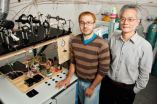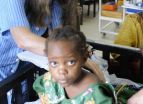This special session will take place on November 17, 2010 at the 2nd Pan-American/Iberian Meeting on Acoustics, a major conference on the science and technology of acoustics held in Cancun, Mexico.
Some of these researchers will be presenting original data on the spill itself and its environmental impact.
Thomas Weber and colleagues at the University of New Hampshire in Durham and the National Oceanic and Atmospheric Administration's Alaska Fisheries Science Center and Office of Coast Surveys will talk about Deepwater spill data collected using acoustic technologies originally developed for researching fisheries. For more information on this presentation, see their lay-language paper: http://www.acoustics.org/press/160th/weber.htm
When the deep wellhead burst, Natalia Sidorovskaia of the University of Louisiana at Lafayette found herself in a unique position. As a member of the Littoral Acoustics Demonstration Center of the University of Southern Mississippi, she had been part of a team listening to the waters near this rig for 9 years -- using underwater microphones (hydrophone) to count sperm whales and beaked whales in the area.
"One of our sites was only 9 miles away from the Deepwater Horizon site, said Sidorovskaia.
Thanks to a rapid response award from the National Science Foundation and ship time donated by Greenpeace, Sidorovskaia and two mathematicians were able to revisit to these waters in September and spend a week collecting post-spill data.
By comparing this data to their pre-spill studies, the scientists hope to get an idea of whether the number of whales in the area has changed. They plan to present this new analysis in their talk on November 17.
"Our estimations agree with NOAA's -- about 1,655 sperm whales before the spill," said Sidorovskaia. "If we killed 3 animals in the gulf, it might affect the population in the growth."
Other researchers at the session will present new -- though largely unproven -- ideas for adapting technologies now used to study the structure of the ocean to detect the presence of oil in water as well.
At the University of Southern Mississippi in Hattiesburg, Michael Vera is exploring a technique commonly used to measure temperature gradients in the ocean (ocean-acoustic thermometry) which detects changes in the speed of a sound broadcast through water. Like a lens bending light, ocean water can distort sound in measurable ways that reveal various properties of the ocean.
Vera's computer models, which simulate a Deepwater Horizon-like stream of oil, indicate that the presence of concentrated crude oil should also reveal itself by changing the speed of sound propagation.
"The model suggests that the oil should be detectable near the wellhead," said Vera.
He is working to refine his model with a more realistic simulation of oil that also includes other materials such as methane. Vera has written a lay-language paper about this research, available here: http://www.acoustics.org/press/160th/vera.htm
Mohsen Badiey of the University of Delaware in Newark, Boris Katsnelson of Voronezh University in Russia, and Jim Lynch of the Woods Hole Oceanographic Institute in Massachusetts are investigating another technique used to study the ocean's three-dimensional structure.
Badiey and this team have spent years studying the structure of the ocean near the continental shelf using sound sources and receivers -- ships and moored points that broadcast sound and arrays of sensors in shallow waters that detect the refraction patterns of this sound. Their recent findings reveal that the three-dimensional nature of sound propagation can be used to detect the boundaries of fluids with different indexes of sound refraction.
"This is a rather unusual approach for ocean acoustics," said Lynch. "For almost a century, almost all work has been 2-D slices of sound."
Any kind of stratified front -- gradients of temperature or density -- can cause interferences and perturbations in this sound. Measurements of these interference patterns have recently revealed information about propagating internal waves on the New Jersey continental shelf.
Their preliminary theoretical calculations give them hope that this technique could be adapted to detect oil spills and other liquids in large-scale areas of water up to few thousand square kilometers on the oceanic shelf.
### For more information about the session, including several other presentations not described above, see page 24 of the meeting program: http://asa.aip.org/cancun/wednesdayam.pdf
MORE INFORMATION ABOUT THE 2ND PAN-AMERICAN/IBERIAN MEETING ON ACOUSTICS
The 2nd Pan-American/Iberian Meeting on Acoustics takes place at the Fiesta Americana Grand Coral Beach Hotel in Cancun, Mexico, Monday through Friday, November 15-19, 2010. The Fiesta Americana Grand Coral Beach Hotel is located at Blvd. Kukulcán km. 9.5, Cancún Hotel Zone, Cancún, Q.R., 77500. The hotel's main numbers are +52 (998) 881 32 00 and, toll-free, 1-888-830-9008.
USEFUL LINKS
Main meeting website:
http://asa.aip.org/cancun/cancun.html
Full meeting program:
http://asa.aip.org/cancun/program.html
Searchable index:
http://asa.aip.org/asasearch.html
Hotel site:
http://www.fiestamericanagrand.com/portal/p/es_MX/FAG/FCB/1/0/Availability/showMinisitioM2.do?showContenido=/descripcionhotel/FCBdescripcionhotel_M2.html&idioma=en_MX
WORLD WIDE PRESS ROOM
ASA's World Wide Press Room (www.acoustics.org/press) contains tips on dozens of newsworthy stories and with lay-language papers, which are 300-1200 word summaries of presentations written by scientists for a general audience and accompanied by photos, audio and video.
PRESS REGISTRATION
We will grant free registration to credentialed full-time journalists and professional freelance journalists working on assignment for major news outlets. If you are a reporter and would like to attend, please contact Jason Bardi (jbardi@aip.org, 301-209-3091), who can also help with setting up interviews and obtaining images, sound clips, or background information.
ABOUT THE ACOUSTICAL SOCIETY OF AMERICA
The Acoustical Society of America (ASA) is the premier international scientific society in acoustics devoted to the science and technology of sound. Its 7,500 members worldwide represent a broad spectrum of the study of acoustics. ASA publications include The Journal of the Acoustical Society of America -- the world's leading journal on acoustics -- Acoustics Today magazine, books, and standards on acoustics. The society also holds two major scientific meetings each year. For more information about ASA, visit our website at: http://asa.aip.org
END



